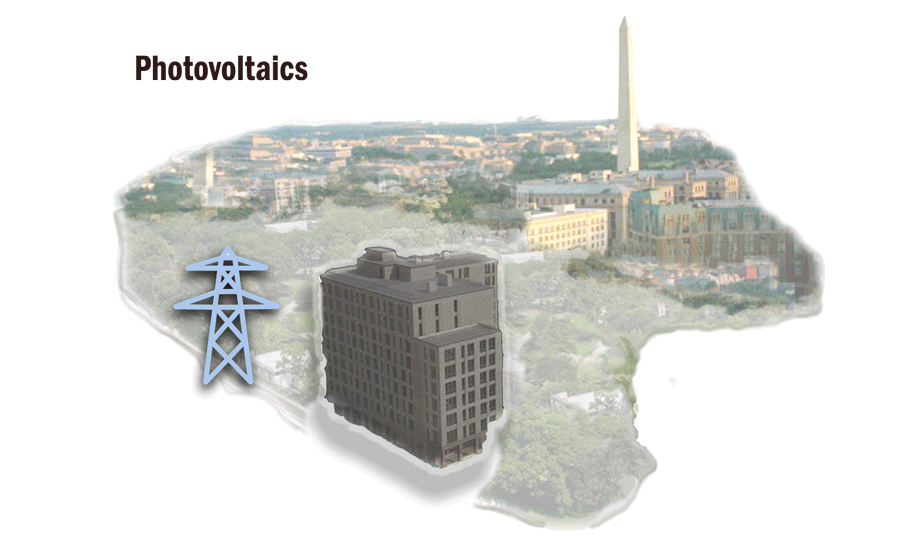1. Congratulations! You’ve already taken the first step towards understanding if a solar installation is right for you.
Many people are starting to see how solar energy could help them cover capital expenditures, reduce carbon emissions and boost ESG ratings, earn revenue, and benefit their community. We’re happy to provide you with a better understanding of the benefits of solar and options that are available to you early in the process.
At New Columbia Solar, we work with commercial and industrial property owners in Washington, DC. We work with businesses, organizations, and religious groups in-between. Our projects vary in size and type, and have included schools, hospitals, stadiums, churches, synagogues, and more. We make solar as easy as possible and have a variety of flexible structures to provide financing or our construction services based on your needs
2. The solar industry has its own lingo.
The solar industry has its own terms and acronyms, which can make some of the terms seem more complex. Throughout the solar installation process, we break them down into clear, straightforward concepts that make you confident in your decisions. In this blog, I highlight the solar terms in blue, which I define in a glossary at the end of this post.

3. It’s easy to get excited about solar once you learn about the benefits.
We don’t send a full team up to your roof to install the panels the second you tell us you’re interested in solar energy–there are many steps in-between with plenty of room for your questions, conversations, and potential concerns. Out of the hundreds of clients I’ve worked with, some have decided that solar isn’t right for them–and that’s okay. Most, though, become even more excited about the process as they learn about our experience, meet members of our team, and come to understand the benefits.
During the first stage in the solar development process, after you convey interest, our business development team will present you with a proposal that’s customized for your property and will walk through the offerings and potential revenue associated with each.
At a high level, here are some of our financial offerings:
- Fixed Lease Payments: In this arrangement, New Columbia Solar exports energy directly from your rooftop into the grid. Property owners will receive lease payments for the use of their otherwise unused space. We refer to these projects as community renewable energy facilities (CREFs), or community solar, because other people will subscribe to use the energy generated by your solar project.
- Discounted Solar Energy: In this arrangement formally known as a “Power Purchase Agreement” or “PPA,” we provide property owners with a significantly discounted stream of electricity from a solar system hosted on the property. This deal structure works through what’s called Net Energy Metering (NEM). Typically, we’re able to offer electricity at a rate that’s typically 30-90% lower than current energy rates.
- Capital Improvements: We can provide property owners with upfront capital to subsidize the cost of capital improvements. This option is compatible with both the fixed lease payments and discounted solar energy options outlined above.
With all of these offerings, we can also show you how much carbon dioxide equivalent (CO2e) your system will offset, which is based on the size of your system in kilowatt hours (kWh) of electricity your system will produce. In the glossary, in addition to kWh, I define kilowatts (kW) and megawatts (MW).
You’ll tell us which structure makes the most sense for you, and together, we’ll perform a site walk to understand your electricity needs, physically inspect your roof, and work together to finalize your offer. After we finalize a contract, we assign you with your own Project Manager to make our project design into a reality.

4. Yes, we actually provide solar energy at no-cost. Here’s how:
We get this question a lot as our clients review our offerings, and the shortest explanation is that our company is able to take advantage of federal and state level incentives. There are so many benefits in the District to install solar that we can actually pass along most of the financial benefits to you while keeping the incentives, solar renewable energy credits (SRECs), that are made for those taking on the steep upfront financial investments and managing the performance of the system. We raise capital from banks to assume the up-front risk of your project and have a team of operations and maintenance experts who know how to adhere to manufacturer requirements, regulations, and respond to technical issues.
5. The best way to choose a solar developer is to think about who you’d like to partner with for 15 to 20 years.
New Columbia Solar is in it for the long run–we want you to view us as your trusted energy partner even beyond the lifetime of the project. We also make our investment back by ensuring the project operates successfully. To ensure we’re positioning the project for success from the start, I work with you to ensure your roof is the condition and has the coverage to support the solar project for its 15- to 20-year lifetime. If you need roof care and coverage, we put you in touch with our partner Fortis Warranty, a commercial roof warranty company that operates in 48 states, six countries, and provides bankable, secure warranties that are backed by Lloyd’s of London. After the project is installed, we also have an Asset Management and Operations & Maintenance Team that will monitor your system and keep you covered.
Interested in learning more? Contact us to ask one of our in-house educators questions that are more specific to your interests and property needs.
GLOSSARY:
- Carbon Dioxide Equivalent (CO2e): The mass of emissions (normally in metric tons, or MT) by its global warming potential. CO2e would relate the global warming potential of the greenhouse gas in question to the same global warming potential as carbon dioxide (which has a GWP of 1).
- Community Renewable Energy Facilities (CREF): When the solar project installed on your property provides power to the electrical grid, therefore not impacting your utility use or bills. Instead, you receive lease payments to rent the space to the solar providers.
- Kilowatts (kW): A measure of how much power is produced (or consumed). 1 kW = 1,000 watts.
- Kilowatt Hours (kWh): A measure of how much energy is produced (or consumed) in one hour.
- Megawatts (MW): 1,000 kWs is equal to 1 MW.
- Power Purchase Agreement (PPA): When you use the power generated by the solar project installed on your property, and therefore, you receive financial benefits via energy savings.
- Net Energy Metering (NEM): A crediting system between you and your utility where you receive credit for excess electricity generated by your solar panels and draw upon credits when you use energy supplied by the grid (e.g., at nighttime).
- Solar Renewable Energy Credits (SRECs): SRECs are like vouchers that are generated by the production of your system, with 1MWh = 1 SREC. The value of SRECs vary by state and cannot be sold directly to utilities.
- Solar Site Walk: A critical step after you expressed interest in solar, and before your project is designed, where an expert comes to your property and physically assesses your roof condition, site suitability, and any features that might impact the layout.
